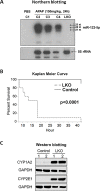Role of Noncoding RNAs in Acetaminophen-Induced Liver Injury
- PMID: 33757622
- PMCID: PMC8201654
- DOI: 10.3727/105221621X16165282414118
Role of Noncoding RNAs in Acetaminophen-Induced Liver Injury
Abstract
Genomic and transcriptomic analyses have well established that the major fraction of the mammalian genome is transcribed into different classes of RNAs ranging in size from a few nucleotides to hundreds of thousands of nucleotides, which do not encode any protein. Some of these noncoding RNAs (ncRNAs) are directly or indirectly linked to the regulation of expression or functions of 25,000 proteins coded by <2% of the human genome. Among these regulatory RNAs, microRNAs are small (2125 nucleotides) RNAs that are processed from precursor RNAs that have stemloop structure, whereas noncoding RNAs >200 nucleotides are termed long noncoding RNAs (lncRNAs). Circular RNAs (circRNAs) are newly identified lncRNA members that are generated by back-splicing of primary transcripts. The functions of ncRNAs in modulating liver toxicity of xenobiotics are emerging only recently. Acetaminophen (N-acetyl-para-aminophenol, paracetamol or APAP) is a safe analgesic and antipyretic drug at the therapeutic dose. However, it can cause severe liver toxicity that may lead to liver failure if overdosed or combined with alcohol, herbs, or other xenobiotics. This review discusses the role of ncRNAs in acetaminophen metabolism, toxicity, and liver regeneration after APAP-induced liver injury (AILI).
Conflict of interest statement
The authors declare no conflicts of interest.
Figures



References
-
- Mitchell JR, Jollow DJ, Potter WZ, Gillette JR, Brodie BB. Acetaminophen-induced hepatic necrosis. IV. Protective role of glutathione. J Pharmacol Exp Ther 1973;187(1):211–7. - PubMed
-
- Jollow DJ, Thorgeirsson SS, Potter WZ, Hashimoto M, Mitchell JR. Acetaminophen-induced hepatic necrosis. VI. Metabolic disposition of toxic and nontoxic doses of acetaminophen. Pharmacology 1974;12(4–5):251–71. - PubMed
Publication types
MeSH terms
Substances
Grants and funding
LinkOut - more resources
Full Text Sources
Other Literature Sources
Medical
